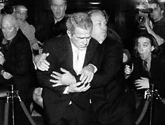
Not many people get to kill the president and get away with it, and director Gabriel Range is no exception. Predictably, “Death of a President”, Range’s technically brilliant but muddled faux-documentary about the fictionalized October 2007 assassination of George W. Bush has been widely criticized before it even hit theatres. Echoing the standard conservative response to the film’s premise, Gretchen Essel of Texas GOP complained, “I find it disturbing. I don’t know if there are many people in America who would want to watch something like that.” Asked about the film, a White House spokeswoman said, “It doesn’t dignify a response.” The film, which opens today, is playing only in independent and art house theaters because two of the nation’s largest theater chains will not show it.
With all the commotion about whether it’s appropriate to depict the future assassination of a sitting chief executive, you’d expect the film at the center of the fracas to be explicit, exciting, and ultimately, subversive. Unfortunately, “Death of a President,” which won the International Critics Prize at the Toronto Film Festival, doesn’t live up to the hype. One of its main draws—and the source of its controversy—is its skillful blending of real footage of Bush with staged scenes and doctored film to create a flawless rendition of an imaginary assassination. Yet despite the film’s suspenseful, if seditious, premise, what starts as a convincing docudrama devolves into a meandering whodunit with an unoriginal political message.
The film opens with Air Force One landing in Chicago, where Bush is scheduled to address a group of local entrepreneurs. Stylistically, the set-up is convincing, with all the staples of a historical documentary: footage from local TV crews, talking-head interviews with forensic experts and Secret Servicemen, camcorder shots of rowdy protesters, and reenactments. This lead-up to the assassination is riveting, especially since we know what’s coming. But once the shots are fired about one-third of the way through the film, things get messy. The search for the sniper begins, but the true-crime thrills that would have been consistent with the documentary approach take a back seat to the personal stories of the accused. Viewers are led on a jumpy, confusing ride through a bungled investigation into the three main suspects, an activist who came out to protest the president’s visit, an Iraq vet with a drug problem, and a Syrian man who once trained with Al Qaeda.
The suspects are largely stereotypes with little personality, but they do pull some emotional punches. “We came here for freedom,” laments the Syrian’s wife, “And this is the freedom you gave us.” The most interesting of the three is Casey Claybon, a disillusioned Iraq vet whose brother was killed by an improvised explosive device and who’s not really sure why he was picked up. Although “my experience in Iraq was slaughter. We was fightin’ arrows with guns over there,” he says he wasn’t part of the protests that preceded Bush’s death. “It didn’t make no sense to me to be out there yellin’ and protestin’ when he [Bush] wasn’t gonna listen nohow.”
While the suspects ramble on about their views on Iraq and the war on terror, “Death of a President” neglects the far more interesting narrative Range has set up back in Washington, D.C. Dick Cheney, of course, is now president, and he’s quick to use Bush’s assassination to serve his own agenda. Once the Syrian is detained, Cheney pulls a page from his search for a nonexistent connection between Iraq and 9/11, telling doubtful forensic analysts to “go over it again, see if it links to him in anyway.” He orders ships to the Middle East and tries to get Congress to declare war on Syria. “Cheney had been obsessed with Syria,” says one former government official. “He had wanted to get rid of [President Bashar] al-Assad for years.” Cheney is unsuccessful in getting his war, but he does expand the Patriot Act into the Patriot Act III. This time the law is passed permanently.
Gabriel Range says the goal of “Death of a President” was to “arouse discussion about the impact of 9/11 on American life.” Yet it’s not entirely clear why he chose the hypothetical assassination of George W. Bush as the right vehicle for this message. One wonders why he chose to bury his suspenseful plot in a predictable condemnation of the current climate of fear. These political themes, as expressed through his paper-thin characters, manage to resonate, yet they don’t tell us anything we don’t already know. It’s as if Range stepped forward to catch his movie’s artistic bullet before it could hit the audience.
















